Menus
- Model type FZR 1000 2LA to YZF 1000 R Thunderace
- Type 3LE highlight of the series
- Model history – Yamaha FZR 1000
- Market situation
- technology
- Comment by Ralf Schneider on the FZR 1000
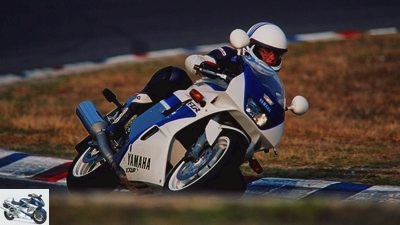
Frank Herzog, MOTORRAD Archive, Yamaha
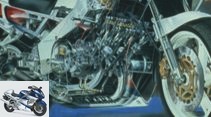
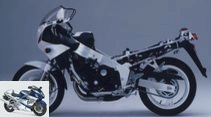
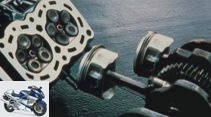
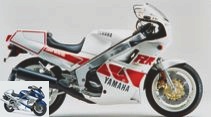
14th photos
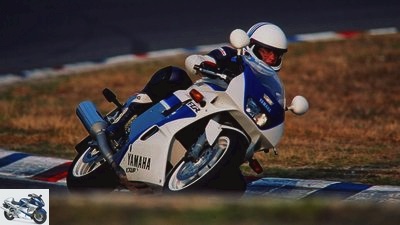
Frank Herzog, MOTORRAD Archive, Yamaha
1/14
An unthrottled FZR 1000 was considered the speed bike par excellence in the late 80s and early 90s.
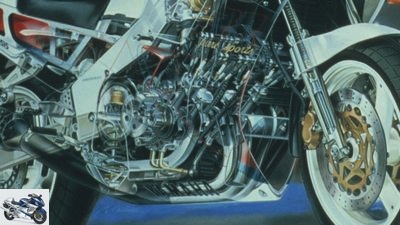
Frank Herzog, MOTORRAD Archive, Yamaha
2/14
The FZR comes with a water-cooled five-valve four-cylinder.
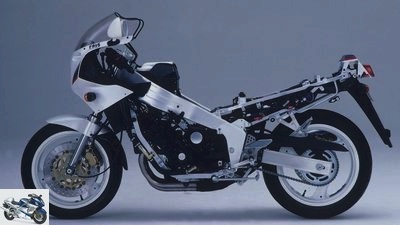
Frank Herzog, MOTORRAD Archive, Yamaha
3/14
The frame consists of large aluminum profiles.
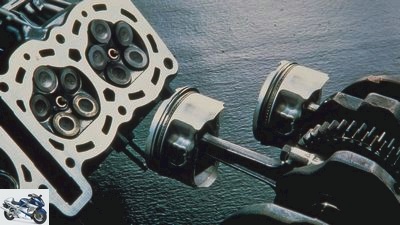
Frank Herzog, MOTORRAD Archive, Yamaha
4/14
Five valves require complex machining of the cylinder head.
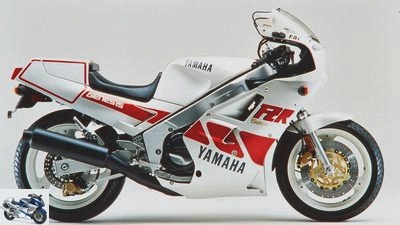
Frank Herzog, MOTORRAD Archive, Yamaha
5/14
Yamaha FZR 1000 2LA (1987): Apart from the highlights of the engine and frame, the first FZR shone with ergonomics that integrated the rider into the motorcycle to inspire confidence and with good wind protection.
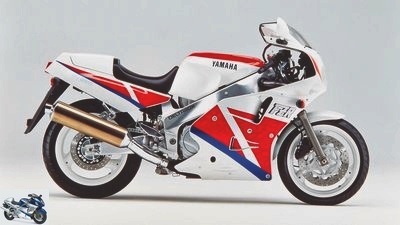
Frank Herzog, MOTORRAD Archive, Yamaha
6/14
Yamaha FZR 1000 3LE (1989): The first with the Exup system, 1002 instead of 990 cm³ displacement, new frame and new swing arm. The power of the unthrottled version rose from 135 to a nominal 144 hp.
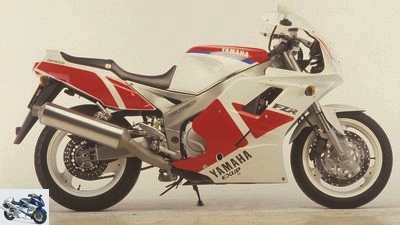
Frank Herzog, MOTORRAD Archive, Yamaha
7/14
Yamaha FZR 1000 3LE (1991): The most noticeable changes are the new upside-down fork and the DE projection headlights.
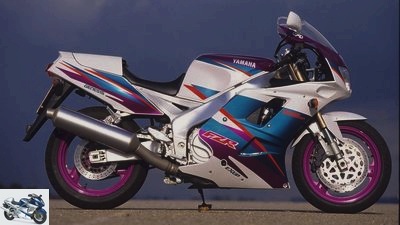
Frank Herzog, MOTORRAD Archive, Yamaha
8/14
Yamaha FZR 1000 3LE (1994): Fox Eye was the name of the diagonally cut double headlights that were placed in the modified fairing instead of the DE light.
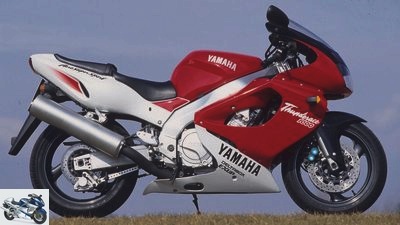
Frank Herzog, MOTORRAD Archive, Yamaha
9/14
Yamaha YZF 1000 R Thunderace (1997): The Thunderace served as an interim model that had to bridge the time until the YZF-R1 was completed.
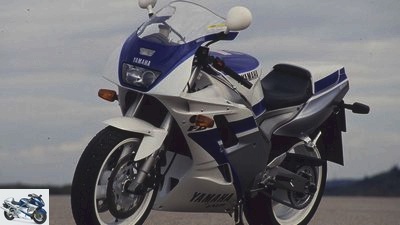
Frank Herzog, MOTORRAD Archive, Yamaha
10/14
Yamaha retained the five-valve technology as a unique selling point until 2006.
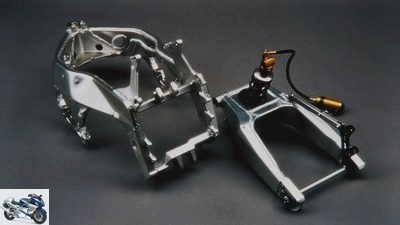
Frank Herzog, MOTORRAD Archive, Yamaha
11/14
Not only the frame of the 3LE is a complex part, but also the swing arm. It is strongest in the area of the highest bending moment.
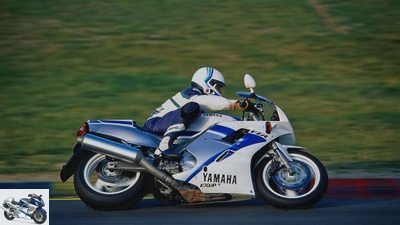
Frank Herzog, MOTORRAD Archive, Yamaha
12/14
Here the FZR shows where the Exup roller is. Visually highlighted by burnt-in street dirt.
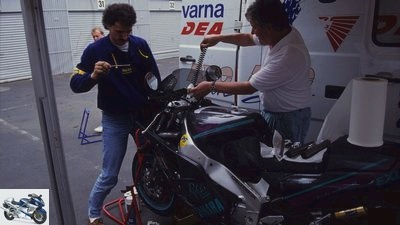
Frank Herzog, MOTORRAD Archive, Yamaha
13/14
Gerhard Gunther (left) and Josef Zupin assembling the Ohlins fork spring set for the 1990 FZR.
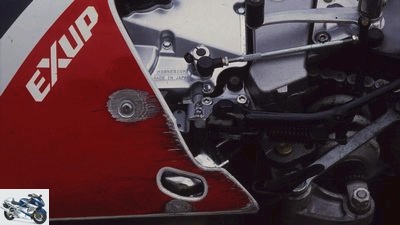
Frank Herzog, MOTORRAD Archive, Yamaha
14/14
This is not exactly the FZR fairing flank I almost lost. But it also illustrates the problem impressively.
Yamaha FZR 1000 in the youngtimer check
Model type FZR 1000 2LA to YZF 1000 R Thunderace
Content of
With or without Exup – the FZR 1000 is an outstanding representative of the era in which real super sports cars had a displacement of 750 cc and sporty 1000s ironed the waves with the elegance and power of racing yachts.
E.An unthrottled FZR 1000 was considered the speed bike par excellence in the late 80s and early 90s: lighter and more stable than the Kawasaki ZZR 1100, more stable than the first Suzuki GSX-R 1100, lighter than the Honda CBR 1000 F and later GSX- R 1100, also beautifully processed and finished with elaborate details such as the rear axle mount in prismatic bearings or the ellipsoid headlight. It found the best place between the Saurians and the 750 Superbikes, drew enormous power from the large displacement and, thanks to the racing-inspired chassis technology, brought it to the road more safely than any other.
Type 3LE highlight of the series
The FZR 1000 of the type 3LE, offered in various updates from 1989, was the high point of the series, but the original model of the type 2LA already caused quite a sensation. Until the mid-1980s, the Yamaha model range had mainly consisted of air-cooled engines in tubular steel frames. Avant-garde designs such as the XZ 550 with a water-cooled four-valve V2 had crashed. Only with the FZ 750 from 1985 did progress go in the right direction. Yamaha brought a sensational water-cooled in-line four-cylinder with five valves per combustion chamber and, as a result, the chassis technology up to date. Since the OW61 from 1982, the first 500cc racing machine with a V4 engine, the engineers had continuously developed the light alloy bridge frame. At the beginning of the 1987 season, one year after the Honda VFR 750 F, it was ready for large-scale production.
However, if you look closely at the chassis of the first Genesis FZR, you will also discover signs of doubt as to whether a frame open at the bottom with a supporting motor would actually be stable and durable. Screwed frame beams connected not only the steering head with the swing arm area, but also the new with the old. The frames of the FZR 750 R OW01 Superbike base and the FZR 1000 3LE developed at the same time, with their powerful, distinctly three-dimensional profiles, dispelled any last doubts about driving stability. In addition, the engines received a newly developed exhaust flap system, with the help of which the torque in the middle range was increased without sacrificing top performance. Its name became the epitome of a legendary series: Exup.
Model history – Yamaha FZR 1000
FZR 1000 2LA (1987)
Frank Herzog, MOTORRAD Archive, Yamaha
Yamaha FZR 1000 2LA (1987): Apart from the highlights of the engine and frame, the first FZR shone with ergonomics that integrated the rider into the motorcycle to inspire confidence and with good wind protection.
Apart from the highlights of the engine and frame, the first FZR shone with ergonomics that integrated the driver into the motorcycle to inspire confidence and with good wind protection. Driving stability depended on the tires. Modern radial tires worked better than bias tires.
FZR 1000 3LE (1989)
Frank Herzog, MOTORRAD Archive, Yamaha
Yamaha FZR 1000 3LE (1989): The first with the Exup system, 1002 instead of 990 cm³ displacement, new frame and new swing arm. The power of the unthrottled version increased from 135 to a nominal 144 hp.
The first with the Exup system, 1002 instead of 990 cm³ displacement, a new frame and a new swing arm. The power of the unthrottled version increased from 135 to a nominal 144 hp. Instead of the 18-inch rear wheel, the FZR got a 5.5-inch-wide 17-inch model, and the front wheel got a thick 130 mm tire.
FZR 1000 3LE (1991)
Frank Herzog, MOTORRAD Archive, Yamaha
Yamaha FZR 1000 3LE (1991): The most noticeable changes are the new upside-down fork and the DE projection headlights.
The most noticeable changes are the new upside-down fork and the DE projection headlights. The engine received a more powerful cooling circuit and a water-flushed oil cooler. The fenders as well as the front and rear panels have been redesigned.
FZR 1000 3LE (1994)
Frank Herzog, MOTORRAD Archive, Yamaha
Yamaha FZR 1000 3LE (1994): Fox Eye was the name of the diagonally cut double headlights that were placed in the modified fairing instead of the DE lamp.
Fox Eye was the name of the diagonally cut double headlights that were placed in the modified fairing instead of the DE light. New six-piston brake calipers increased the already impressive braking performance, and the fork and transmission were redesigned.
YZF 1000 R Thunderace (1997)
Frank Herzog, MOTORRAD Archive, Yamaha
Yamaha YZF 1000 R Thunderace (1997): The Thunderace served as an interim model that had to bridge the time until the YZF-R1 was completed.
The Thunderace served as an interim model that had to bridge the time until the completion of the YZF-R1. Simpler in structure and equipment than the FZR, it helped to save production costs. That didn’t damage the function; the great Ypse remained a reliable touring athlete.
Market situation
Anyone looking specifically for an FZR 1000 will easily find one, even if they sort out the more or less successful Streetfighter and Superbike handlebar conversions from the range. Examples from the Genesis series up to and including 1988 are very rare, as are 3LE models with less than 40,000 kilometers. Such motorcycles with between 40,000 and 60,000 kilometers on the clock are usually offered for prices of 1,500 to 3,000 euros. The processing quality corresponds to a high Japanese standard. With competent, not even excessive care and maintenance, the FZR can be kept in good condition for a very long time.
Frank Herzog, MOTORRAD Archive, Yamaha
In the late 80s and early 90s, the FZR 1000 was considered the speed bike par excellence.
With one caveat: in principle, it doesn’t hurt to run a correctly adjusted engine that has been warmed up at high speeds. However, the FZR four-cylinder engines are sensitive to high continuous speeds. Because of the large distance between the third and fourth crankshaft main bearings, the crankshaft develops bending vibrations in the range of five-digit speeds, which impair the lubrication of the bearings. At least the engine of the GTS 1000 and the YZF 1000 R Thunderace, both based on the FZR engine, proved to be susceptible to bearing damage in the endurance test. It doesn’t seem to have been isolated cases, because Yamaha changed the crankshaft bearings in the Thunderace engine – the last version of the 1002 cm³ four-cylinder – in the current series. Less dangerous, but hardly less expensive to replace, are the shaft seals of the exhaust valves, which can be enlarged oval after 50,000 kilometers and cause oil consumption and coked exhaust valves.
technology
What exactly is the term "Genesis Concept" thinks I still don’t know. In addition, I do not consider the FZR models to be so significant that reminiscences of the biblical story of creation force themselves. Anyway, with the FZR, Yamaha has reinvented motorcycle technology for itself and formulated the goal of developing motorcycles as a harmonious whole. Of course, they have already come pretty close to this goal with a number of motorcycles. The achievement of the chassis developers consists in using the light but little tensile strength material aluminum in the way that corresponds to its properties. Large cross-sections instead of thin round or square tubes, moderate bending angles instead of sharp corners, and where complex shapes were required, the combination with cast parts. The development of reliable welding technology was also important for large-scale production. If you look at the frame of the 3LE shown below, you suspect that the engineers already knew exactly where rigidity and where flexibility was required. A construction that can still be seen today.
Frank Herzog, MOTORRAD Archive, Yamaha
The frame consists of large aluminum profiles.
The engine is different. The central camshaft drive in particular is difficult to understand. With the GPZ 900 R from 1984, Kawasaki had demonstrated how an in-line four-cylinder with only five crankshaft main bearings can be realized with the side-by-side arrangement of the timing chain. Yamaha wanted the central camshaft drive, but saved the sixth crankshaft bearing because it ran more smoothly, which posed a problem. What had worked with the air-cooled Honda engines of the 1970s turned out to be susceptible beyond 100 hp and 9,000 rpm. Yamaha retained the five-valve technology as a unique selling point until 2006. Only the YZF-R1 of type RN19 received a four-valve cylinder head in 2007. The latest findings on gas flow and combustion spoke in favor of the simpler, yet more efficient solution.
Comment by Ralf Schneider on the FZR 1000
Ralf Schneider, test editor
Yamaha FZR 1000 – at this keyword a flood of memories crashes on me. First and foremost is the famous tune-up (PS 8/1992), which we produced in the summer of 1992 during five days of paradise on the Nurburgring Nordschleife. Except for a brief thunderstorm on the last day, the sun was shining all the time; We drove every day from morning to evening, trying an unimaginable 29 different tire combinations, plus suspension elements, footrests and exhaust systems, spoiler discs and steering dampers. A doctoral thesis on accessories.
mps photo studio
Ralf Schneider about the Yamaha FZR 1000.
We, that was my friend and colleague Raphael Schmidt, who unfortunately died much too early, PS mechanic Mike Funke and me. We received support from the Metzeler racing service and in this case also from Josef Zupin and his son-in-law Gerhard Gunther. The reason for this was actually not that good. Zupin, at that time the sole Ohlins importer for Germany, was dissatisfied with the performance of its products in previous tune-ups and wanted to see, "what the idiots of PS" held before they criticized its noble parts. As soon as they arrived, the two of them did a lap on the Nordschleife in the car, and it was really pure coincidence that Raphael and I overtook them. I think that was on the exit of the triple left after the mine, so that they could still see our front wheels snapping briefly into the air above the crest. Then the ice was broken. Gerhard put a strut together according to our wishes. Combined with a fork spring set, which unfortunately was only available for the conventional fork of the 89/90 FZR at the time, it worked just like a dream. With the spindle we raised the rear, which made the FZR almost a handy motorcycle. In addition, there was a fine response and rich damping – the whole thing seemed like a real bump-iron.
Frank Herzog, MOTORRAD Archive, Yamaha
Five valves require complex machining of the cylinder head.
This chassis, with Michelin Hi-Sport TX 11 / TX 23 tires, became our tune-up king. Allegedly, Zupin took over the setup as the standard for the Ohlins struts for the FZR. Raphael and I only disagreed about the optimal size of the front tire. There was a choice of a 120/60 ZR 17, a 120/70 ZR 17 and a 130/60. Raphael preferred the 120/60 because of the better front wheel feel when braking in an inclined position, the 120/70 instilled in me more confidence, whose damping behavior was ideal for me with the fork set-up. I drove the 130/60 out of a pure sense of duty. I started a brisk lap, perfectly shot in, but after just a few turns I was amazed at a guy who was constantly dancing around in the rear-view mirrors. With an FZR 1000. I couldn’t shake him off, but he didn’t want to overtake either. Then I tackled the fast links on Metzgesfeld a little too quickly, because of the wide front tire, the FZR needed a bit more lean angle than with the 120/70 and therefore hit the left side of the fairing over a large area and harder than before. Sliding gently on the driver’s knees, tires and fairing, the Yamaha wanted to steal away in the direction of the meadow. I managed to recapture them and waved my pesky pursuer over. Raphael later told me that it was Herbert Mandelartz, at that time Helmut Dahne’s main competitor in the fight for the German Motorcycle Rally Championship. I couldn’t hold it, but I was happy to bring the Nurburgring expedition to a close without either of us falling. And "our" FZR 1000 – in truth it belonged to Bodo Schmidt – remained my Nordschleife favorite for many years.
Related articles
-
Youngtimer check: Suzuki GSX-R 750 SRAD (GR7DB, type T to type W-X)
Achim Hartmann, Jorg Kunstle, Frank Herzog, MOTORRAD-Archiv 11 pictures Achim Hartmann, Jorg Kunstle, Frank Herzog, MOTORRAD-Archiv 1/11 Suzuki rolled up …
-
Yamaha FZR 1000 Genesis versus Yamaha YZF-R1
Yamaha FZR 1000 Genesis versus Yamaha YZF-R1 Yamaha’s thousands: the trendsetters With 135 hp in the unthrottled version, five-valve technology, cylinder…
-
Driving report Yamaha YZF 600 R and YZF 1000 R
Driving report Yamaha YZF 600 R and YZF 1000 R In rapid succession Yamaha has a big bang this year, bringing two fresh sprinters into play: Thunderace…
-
Cult bike Yamaha FZR 1000 Exup
Hartmann Cult bike Yamaha FZR 1000 Exup The blast of 1989 Seldom has a motorcycle been improved so dramatically as the already great Yamaha FZR 1000:…
-
Comparison test Honda VTR 1000 F against Suzuki RF 900 R against Yamaha YZF 1000 R
Comparison test Honda VTR 1000 F against Suzuki RF 900 R against Yamaha YZF 1000 R Target group Sporty tourers? Athletes fit for travel? Grand Tourisme…
-
Kawasaki ZL 1000 and Yamaha Vmax
Stefan Wolf 38 photos archive 1/38 The “new” Vmax, in the range since 2008, also shows off superlatives in terms of performance, acceleration and…
-
fact Concept comparison Honda CBR 1100 XX Kawasaki ZX-12 R Suzuki GSX-R 1000 Suzuki GSX 1400 Yamaha FZS 1000 Fazer Yamaha FJR 1300 Six bombs The six most…
-
Yamaha YZF-R1, YZF 1000 R (VT: Nurburgring)
Yamaha YZF-R1, YZF 1000 R (VT: Nurburgring) Yamaha YZF-R1 versus YZF 1000 R Thunderace: Enough is never enough No Japanese currently builds so uncompromisingly …
-
Yamaha YZF-R 125 in the used purchase check
Yamaha 23 pictures Yamaha 1/23 The Japanese woman looks like the face of her bigger sister R1. Yamaha 2/23 To this day, the drive to …
-
Artist Comparative test of evergreens against current top models BMW R 1100 RS versus R 1100 S. Kawasaki ZZ-R 1100 versus ZX-12R Yamaha YZF 1000…